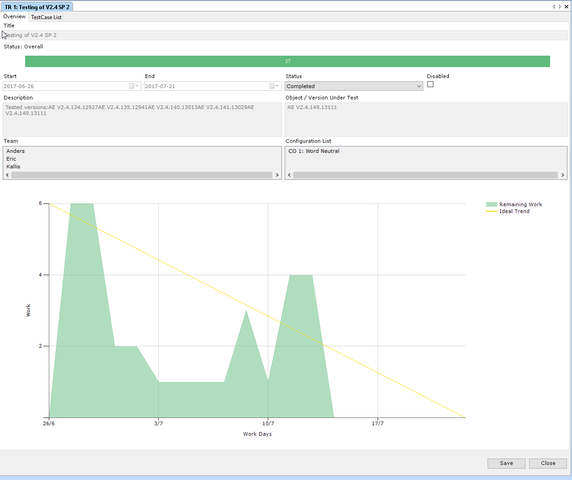Test Management in Medical Device Development
Test managers often have to deal with superhuman juggling of timelines, resource allocations and continuously changing specifications while facing increasing pressure from management as the shipping-date draws closer. Furthermore, the test manager is responsible for making sure that the traceability is completed, that test data integrity remains intact, and that change management procedures are followed correctly, even under situations of extreme stress.
Efficient change management, planning, tracking, and reuse of test executions are therefore much appreciated tools in the V&V Managers toolbox. The Aligned Elements Test Runs aims to address these challenges. The Test Runs manages the planning, allocation, execution, and tracking of test activities. Let's dive into the details.
Planning the Test Run
The Test Run Planning section is the place to define the Test Run context, much as you would write a Verification Plan.
The Test Run Planning information includes:
- What to test i.e. information the Object Under Test and the addressed configurations
- When to perform the tests i.e. the planned start and end date for the Test Run
- Who participates in the test effort i.e. the team of testers and their allocated work
- How to test the device i.e. which test strategy to use by selecting among the existing test types
- Why the test is being done i.e. the purpose or reason for performing this particular set of tests on this Object Under Test

Allocate existing Test Cases from your Test Case library to the Test Run by using simple drag-and-drop. You can use any number of tests of any available types from any number of projects. If needed, add Test Run specific information to the Test Cases and designate the Test Cases to the members of the Test Team.
Once the planning phase is completed, the Test Execution can begin.
The Test Execution phase
Test Case data is kept separate from the Test Execution result data, permitting a high degree of test case reuse and a clear separation between Test Instructions and Test Results.
Consistency checks are optionally carried out on the Test Case before execution in order to ensure that tests cannot be performed until all foreseen process steps are completed.
During execution, the test input data is optionally kept read-only, preventing testers to modify a reviewed and released Test Case during execution.
All Test Team Members can access the Test Run and simultaneously Execute Tests as well as continuously monitor how the Execution phase progresses.

Real-Time Test Execution data is presented through:
- Individual Test Execution results including any found defects as well as colour-coded feedback on states
- Colour coded test progression statistics, with the possibility to drill down on e.g. individual Testers or Test Types
- Burndown charts, showing how planned Test progress over time corresponds to the actual progression
Defect Tracking
During Test Execution, Defects and Anomalies can be created and traced on-the-fly without having to leave the Test Execution context. The Defects can be tracked in either Aligned Elements internal Issue Management system or already existing integrated Issue Trackers such as Jira, TFS, GitHub, Trac or Countersoft Gemini or any mix of these systems. Created Defects and their corresponding status are displayed in the Test Run.

Test Case Change Management
When developing medical devices, it is of paramount importance to keep your Design Control under tight change control.
The Test Run assist the testers and test managers in several ways to accomplish this goal, including optional actions:
- Preventing inconsistent tests from being executed
- Preventing input data to get modified during test execution
- Allowing Test Managers to lock/freeze Design Input and Tests during execution
- Alert testers when attempting to modify tests for which valid results already exist
- Signalize whether a Test Case has been reviewed and released or not
- Allowing the user to explicitly invalidate existing test results when a test is updated with major changes
Testing Variants of the Object Under Test
If several variants of the Object Under Test exist, it is sometimes desirable to create variant-specific test results for common test cases and subsequently create separate traceabilities for the variants. The Test Run uses a concept called "Configurations" to achieve this behaviour. A Test Case is executed for one or more Configurations to make sure that variant-specific test results are kept separate.
The exact data composition of a Configuration is customizable to fit the needs of each customer.
Complete the Test Run
Once all Test Cases has been completed, the Test Run and all its content is set to read-only. Optionally, a Snapshot of all Test Run relevant items is created as part of the completion procedure. A Test Run report containing all the necessary Test Run information can be inserted into any Word Document using Aligned Elements Word Integration with a single drag and drop action.
The Test Run is a Test Managers best friend, providing the flexibility needed during test planning and full transparency during test execution, making it possible to quickly react as real-time test events unfold.
Note: Burn Down Charts is under development at the point of writing and planned to be released in the next service pack.